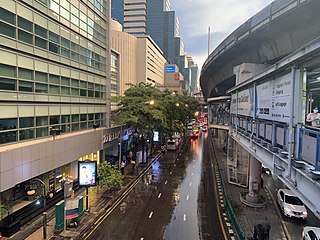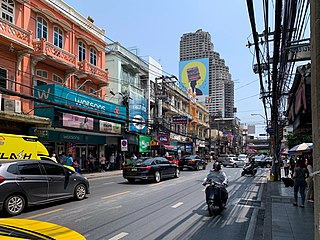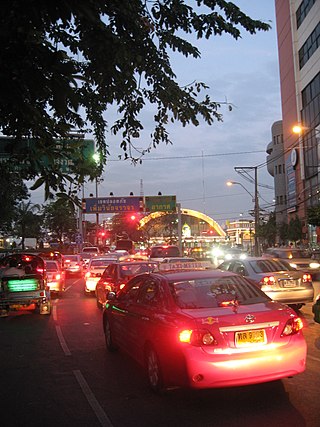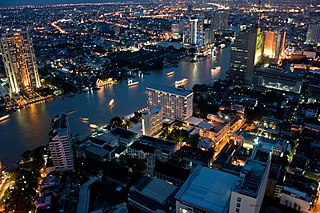
Si Lom Road is a major street in the Thai capital Bangkok, best known for its commercial neighbourhood, which, along with the nearby and roughly parallel Sathon Road, forms one of the city's main business districts. It runs in a southwest–northeast direction between Charoen Krung and Rama IV roads in the city's Bang Rak District, forming the boundary between Suriyawong Subdistrict to its north and Si Lom Subdistrict to its south. Si Lom was one of the earliest modern roads to be built in the city, and some of its side streets serve historic ethnic neighbourhoods from the late nineteenth century, while others are known as shopping and nightlife venues.

Bang Rak is one of the fifty districts (khet) of Bangkok, Thailand. It lies on the eastern bank of the Chao Phraya River, beyond Khlong Phadung Krung Kasem, which marked the old city boundary. Originating from riverside settlements dating from before the city's foundation, Bang Rak grew inland as new roads and canals were constructed through the area during the second half of the nineteenth century and the early twentieth, attracting communities of expatriates and developing into a major commercial district. Bangkok's rapid economic growth in the late twentieth century saw the areas along Si Lom and Sathon roads transformed into one of the city's main business districts, teeming with skyscrapers. The district, officially recognised at least since 1908, covers an area of 5.54 square kilometres (2.14 sq mi), and has a registered population of 48,227. Today, Bang Rak is known for the financial activity of its commercial offices, as well as its vibrant nightlife scenes. Diverse historic and religious sites, most significantly concentrated in Bang Rak Subdistrict on the waterfront, reflect the district's multicultural history.

Sathon or Sathorn is one of the 50 districts (khet) of Bangkok, Thailand. The district is bounded by six other districts : Bang Rak, Pathum Wan, Khlong Toei, Yan Nawa, Bang Kho Laem, and Khlong San.

Bang Kho Laem is one of the 50 districts (khet) of Bangkok, Thailand. The incumbent district officer is Samita Xanthavanij. The district is bounded by Sathon, Yannawa, and across the Chao Phraya River, Rat Burana, Thon Buri and Khlong San districts.
The history of Bangkok, the capital of Thailand, dates at least to the early 15th century, when it was under the rule of Ayutthaya. Due to its strategic location near the mouth of the Chao Phraya River, the town gradually increased in importance, and after the fall of Ayutthaya King Taksin established his new capital of Thonburi there, on the river's west bank. King Phutthayotfa Chulalok, who succeeded Taksin, moved the capital to the eastern bank in 1782, to which the city dates its foundation under its current Thai name, "Krung Thep Maha Nakhon". Bangkok has since undergone tremendous changes, growing rapidly, especially in the second half of the 20th century, to become the primate city of Thailand. It was the centre of Siam's modernization in the late 19th century, subjected to Allied bombing during the Second World War, and has long been the modern nation's central political stage, with numerous uprisings and coups d'état having taken place on its streets throughout the years.

Charoen Krung Road is a major road in Bangkok and the first in Thailand to be built using modern construction methods. Built during 1862–1864 in the reign of King Mongkut, it runs from the old city centre in Rattanakosin Island, passes through Bangkok's Chinatown, continues into Bang Rak district, where it formerly served the community of European expatriates, and ends in Bang Kho Laem. Construction of the road marked a major change in Bangkok's urban development, with the major mode of transport shifting from water to land. Charoen Krung Road was Bangkok's main street up to the early 20th century, but later declined in prominence. It is still home to many historic buildings and neighbourhoods, which are beset by changes as extension of the underground MRT is poised to drive new development.

Sathon Road is a major road that passes through the districts of Bang Rak and Sathon in central Bangkok, Thailand. It is an important transportation link between Phra Nakhon and Thonburi sides of Bangkok.
Bangkok, the capital of Thailand, is one of the world's top tourist destination cities. Each year, approximately 22.7 million international visitors arrive in Bangkok. MasterCard ranked Bangkok as the world's top destination city, with 15.98 million projected visitors in 2013. It topped the MasterCard Global Destinations Cities Index as the most visited city in the world in 2012, 2013, 2016, 2017 and 2018. The city is ranked fourth in cross-border spending, with 14.3 billion dollars projected for 2013, after New York, London and Paris. Euromonitor International ranked Bangkok sixth in its Top City Destinations Ranking for 2011. Bangkok has also been named "World's Best City" by Travel + Leisure magazine's survey of its readers for four consecutive years since 2010.

The Sathon Mansion or Luang Chitchamnongwanit Mansion is a complex of historic buildings in Bangkok, Thailand. It was built in 1888 for Luang Sathonrachayut, the wealthy Chinese businessman who developed Sathon Road, and later served as the Hotel Royal, the Soviet embassy and, since 2015, a restaurant and entertainment venue for the W Bangkok hotel, known as The House on Sathorn.

Captain Bush Lane, now officially known as Soi Charoen Krung 30, is a side-street branching off Charoen Krung Road in Bang Rak District of Bangkok, Thailand. It was home to several members of Bangkok's early European expatriate community during the turn of the 19th–20th centuries, including Captain John Bush, an influential English sea captain after whom the street is named.

The old Customs House is a historic building in Bangkok, located on the eastern bank of the Chao Phraya River in Bang Rak District. It was built in 1888 as one of the many Western-style buildings commissioned by King Chulalongkorn, and was designed by Joachim Grassi in the neo-Palladian style. The building fell into disrepair during the mid-20th century. Beginning in 2019, it is undergoing restoration and re-development as a luxury hotel.

Si Phraya Road is a road in Bang Rak District, Bangkok, Thailand. It divides the areas of Maha Phruettharam and Si Phraya subdistricts. Built in 1906 by four noblemen of the rank phraya, the road runs from Si Phraya Pier at the mouth of the Phadung Krung Kasem Canal to Sam Yan Intersection, where it meets the Phaya Thai and Rama IV Roads.

The Embassy of the United Kingdom in Bangkok is the chief diplomatic mission of the United Kingdom in Thailand. Established as an embassy in 1947, its history dates to 1856 when a British consul was first posted in Bangkok following the signing of the Bowring Treaty. First established on Charoen Krung Road by the Chao Phraya River, the mission relocated to a new site on the corner of Phloen Chit and Witthayu Roads in 1922. Originally a rural location on the outskirts of the city, the area soon developed into one of the city centre's prime locations. The compound remained a leafy oasis amidst its densely developed surroundings throughout the 20th century, but was sold to Central Group at record-setting prices, first partially in 2007, then completely in 2017. The embassy is now based in an office building on Sathon Road, while its original buildings, including the ambassador's residence, have been demolished to make way for redevelopment.

The Embassy of Portugal in Bangkok is the diplomatic mission of Portugal in Thailand. It is located in Bang Rak District, on the eastern bank of the Chao Phraya River, and is served by Soi Charoen Krung 30. Dating to 1820, with the ambassador's residence built in 1860, it is the oldest diplomatic mission in Thailand, and the ambassador's residence has been recognized as an award-winning historic building.

Chaloem Phan 53 Bridge is a bridge in Bangkok's Yan Nawa sub-district, Sathon district and Si Lom sub-district, Bang Rak District.

Surawong Road is a road in the Bang Rak District of Bangkok, Thailand, linking Charoen Krung Road to Rama IV and forming the boundary between Suriyawong and Si Lom subdistricts. It was built at the end of the 19th century during Bangkok's period of expansion following the country's opening up to the West, and was home to many leading businesses, upper-class families, and members of the expatriate community. It was known as a Western-style nightlife entertainment district during the 1920s, and was—and still is—home to many leading hotels. The road grew as a business district along with the nearby Si Lom Road during the mid-20th century, but lagged behind in development toward the end of the century due to its limited traffic capacity. Today, it is still home to several historic landmarks, as well as many well-known restaurants.

The East Asiatic Building is a historic building in Bangkok's Bang Rak District. It sits on the eastern bank of the Chao Phraya River, opposite the Oriental Hotel on Soi Charoen Krung 40 and adjacent to the Catholic Mission and Assumption Cathedral. The building was built c. 1900 in Renaissance Revival style to designs by Annibale Rigotti, and served as the headquarters of the East Asiatic Company (Thailand) until 1995, receiving the ASA Architectural Conservation Award in 1984. In 2023, Asset World Corporation announced plans to renovate the building into a hotel under the Plaza Athénée brand, in partnership with Nobu Hospitality.

Maha Phruettharam is one of the five khwaeng (subdistrict) of Bang Rak District, Bangkok.

Bang Rak is a khwaeng (subdistrict) and historic neighbourhood in Bangkok's Bang Rak District. It lies between the Chao Phraya River and Charoen Krung Road, and was home to communities of European expatriates who settled in the area mostly during the second half of the 19th century as Siam opened up to the West. Among them were the Portuguese, French and British, whose embassies occupied extensive grounds in the area, Danes who founded shipping companies as well as the historic Oriental Hotel, and Catholic missionaries who established some of the first schools in the country on the grounds surrounding Assumption Cathedral.





















